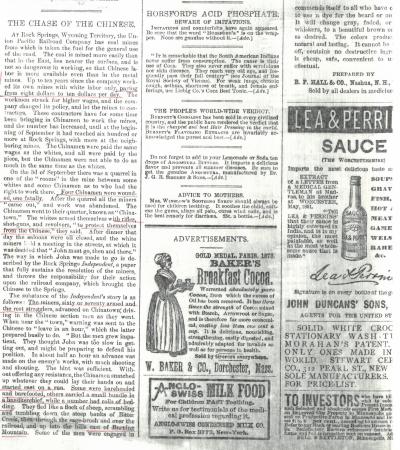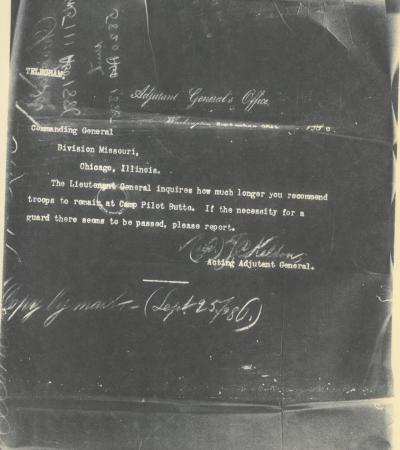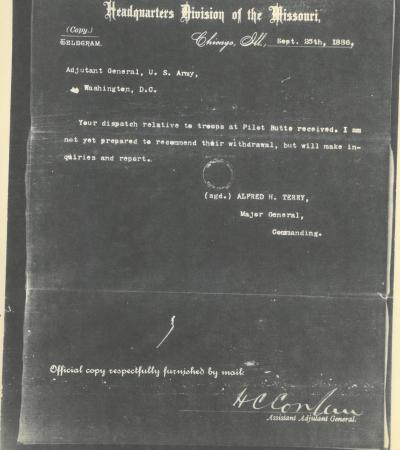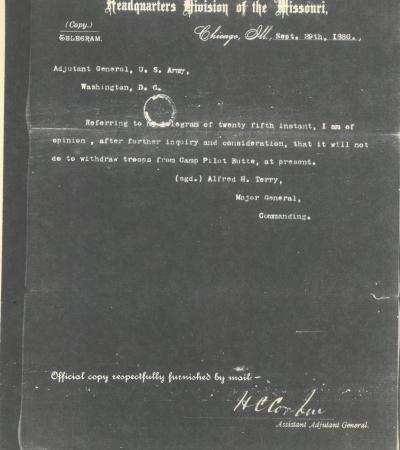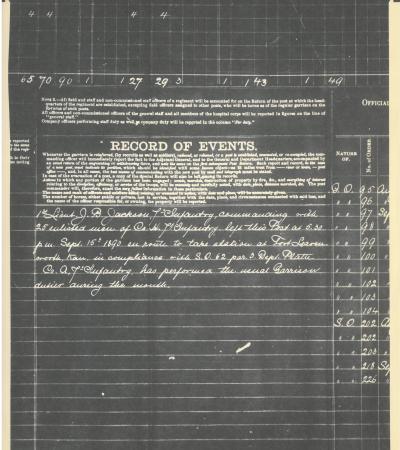Robert Bartlett Rhode was born and raised in central Wyoming. He attended the University of Wyoming and graduated with a degree in journalism. Rhode was a reporter and editor for many Wyoming newspapers and was a professor of journalism at the University of Colorado, University of Southern California, and University of Denver. His first two books were about photography. He wrote Booms and Busts on Bitter Creek: A History of Rock Springs in 1987 after he had retired. Booms and Busts documents the history of violence and corruption in Rock Springs, a mining town in Wyoming.
"The Chase of the Chinese," Harper's Weekly, September 26, 1885, page 638
Article describing the events of the Rock Springs Massacre.
Military Record of Events, Camp Pilot Butte, Wyoming, November 8, 1885
Transcription: In compliance with S.O. #91 Headquarters Department of the Plat. September 14 1885 Company "A' 21" Infantry (two (2) officers and thirty three (33) men [illegible] at this Camp for duty October 21 1885. In pursuance of Special orders no 103 Headquarters Dept. of the Platte, October 15, 1885, the following movements of troops were made from this Camp. Company "C" 9" Infantry and proceeded to [illegible] station Fort D.A. Russell, Wyo. October 19. Companies "A" and "C" 21" Infantry to Fort Sidney, Nebraska October 21.
Military Record of Events, Camp Pilot Butte, Wyoming, December 2, 1885
Transcription: "The troops have performed the usual camp and guard duty during the month. In compliance with telegraphic instructions dated Headquarters Department of the Platte, November 7, 1885, the detachment of 20 enlisted belonging to Company "I 21" Infantry, were relieved from duty at this camps and ordered to join their Company at Fort Fred Steele, Wyo. November 18 1885. Detachment of 20 enlisted men from the different Companies of the 7th Infantry stationed at Fort Laramie Wyo.
Case for authority to call on troops to protect Chinese residents in New Mexico, Adjutant General's Office, January 29, 1886
In addition to the call for U.S. Army military troops to protect Chinese residents in New Mexico, this memo from the Adjutant General's Office outlines communication relating to the Rock Springs Massacre. The Adjutant General's Office was responsible for providing personnel service support by manning the force, providing human resources services, coordinating personnel support, Army band operations, and recruiting and retention. Transcription included.
Telegram from Acting Adjutant General to Commanding General, Division Missouri, Chicago, Illinois, September 25, 1886
Telegram asking how much longer troops should remain at Camp Pilot Butte.
Telegram from Major General Alfred Terry to Adjutant General, U.S. Army, Washington, D.C., September 25, 1886
Reply to telegram from Sept. 25, 1886 telegram from Acting Adjutant General. Major General Terry states that he is not yet prepared to recommend their withdrawal but will make inquiries.
Telegram from Major General Alfred Terry to Adjutant General, U.S. Army, Washington, D.C., September 29, 1886
Major General Terry confirms that, after making inquiries, "it will not do" to withdraw troops from Camp Pilot Butte at this time.
Letter from Adjutant General, U.S. Army to Commanding General, Division of the Missouri, Chicago, Illinois, January 12, 1887
The Adjutant General states that troops are no longer needed at Camp Medicine Butte at Evanston, Wyoming.
Letter from 1st Lieutenant James Brennan, Commanding Office of 17th Infantry, to Adjutant General, Dept. of the Platte, Omaha, Neb., February 9 1887. Letter written from Camp Medicine Butte, Wyoming.
Brennan writes of stopping Rock Springs residents from preventing the extinguishing of a fire in the Chinese quarter and of the "rough element" that are capable of doing great damage. Ah Say is mentioned a leader of the Chinese in Rock Springs.
Military Record of Events, Camp Pilot Butte, Wyoming, July 21, 1887
Transcription: Companies A and H of the Inf. left Fort Laramie Wyo 7th inst. at [illegible] en route to Camp Pilot Butte, marched 6 miles, camped at 6 mile Hill, July 8, marched 18 miles [and] camped at Chug Springs. July 9 marched 18 miles camped at Chug Watter. July 10 marched 19 miles camped at Bard's Ranch. July 11 marched 19 miles camped at 9 mile Ranch. July 12 marched 9 miles to Cheyenne and taken UPRR for Rock Springs. July 13th arrive at Rock Springs at 8:50 A.M. via UPRR relieving Co's. B[?] and C 7th Infantry the same date who proceeded to Fort Laramie Wyo 6:15 P.M.
Military Record of Events, Camp Pilot Butte, Wyoming, October 1, 1890
Transcription: 1st Lieut. J.B. Jackson, 7th Infantry, commanding with 25 enlisted men of Co. H 7th Infantry left this Post at 5:30 p.m. Sept. 15 1890 en route to take station on Fort Leavenworth, Kan. In compliance with S.O. 62 par. 3 Dept. Platt. Co. A, 7th Infantry has performed the usual Garrison duties during the month.
"Chinese Riot," by David G. Thomas as told to his daughter Mrs. J.H. Goodnough, 1931
An eyewitness account of the Rock Springs Massacre. Thomas (1857-1935) was born in Pittsburgh, PA and moved to Missouri at an early age. He came to Rock Springs in 1875 and worked for the Union Pacific Coal Company. At the time of the 1885 riot, Thomas was a mine boss at No. 5. Thomas went on to hold public offices in the Wyoming counties of Uinta and Sweetwater and served a number of years as Wyoming's State Coal Mine Inspector.
Description of Leo Chee, undated
Lao Chee or Leo Chee, also known as "Jim," was a Union Pacific employee who acted as custodian of the company's animal stock and barns in Rock Springs. He was also a helper and foreman in the mines. See resource identifier LaoChee in General AHC Collections for more information.
"The Rock Springs Massacre," paper written and presented by Brigadier General Robert Outsen to the Young Mens Literary Club, January 1966, Cheyenne, Wyoming and to the Laramie County Chapter, Wyoming State Historical Society.
General Outsen recounts the Rock Springs Massacre and memories of Chinese residents in Rock Springs.
